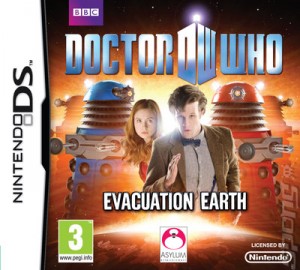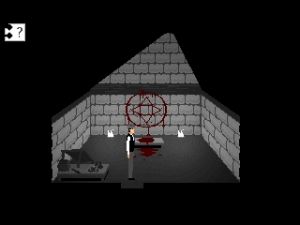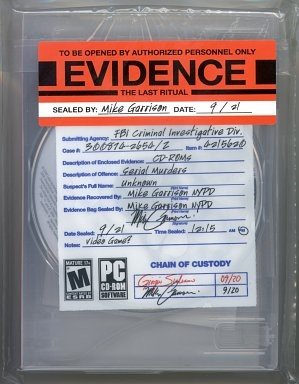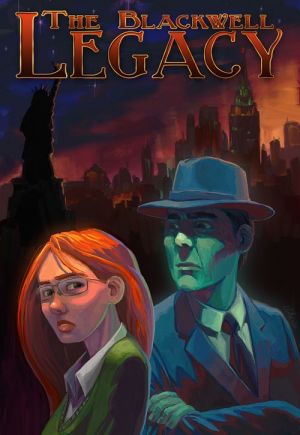Review for Doctor Who: Evacuation Earth

From his first television appearance in 1963, viewers have always wanted to go on adventures with the traveller in time and space known as the Doctor. Since that time, several game developers have tried to bring that dream to fruition with varying degrees of success. Fans of the newly revitalised version of the series have already had a number of opportunities to join him in downloadable interactive PC episodes. Now he has made the jump to consoles for an entirely original adventure, Doctor Who: Evacuation Earth for the Nintendo DS. Thankfully, the feel of the series has largely survived the transition intact, and the Professor Layton-style gameplay fits well with the Doctor’s inquisitive mind, but a lack of puzzle variety and some quality control issues prevent this outing from being a flyaway success.
The story begins with the Doctor and his companion, Amy Pond, travelling in the TARDIS. Given that the ship is capable of moving through both time and space, Amy is initially disappointed to find they are travelling to the Lake District in northern England. Yet this is not the Lake District of Amy’s present day life, but a far future version where life on the Earth’s surface is about to be wiped out by solar storms. Most of the human population has already been evacuated on country-sized starships, but a small band of humans remain, desperately trying to complete their own ship, the Lucy Gray, in time to escape. When the Doctor and Amy leave the TARDIS to explore, it is mistakenly appropriated to aid in this task, and the pair must assist these desperate people in order to get it back. Unwilling passengers on the Lucy Gray, the protagonists soon find that they also have to outwit a band of Silurians and a hostile group of Daleks, both of whom have hitched a ride.
The story of the solar storms is a reference to the 2010 television series episode, “The Beast Below”, which was set on the giant evacuation vessel Starship UK. Appearances by the Doctor’s oldest foe are always popular with fans, and even the lesser-known Silurians will be recognised by many. Having these links to the televised adventures rather than being a completely unrelated story makes players feel like they are directing the protagonists in a missing television episode, giving series fans an immediate investment in the game. However, key series concepts are introduced in natural conversation, giving even non-fans the background needed to get into the Who universe.
Much of the gameplay will seem familiar to players of the popular Professor Layton puzzlers. Whilst Doctor Who can claim to have paired a highly intelligent individual with an assistant first, this game follows Layton’s lead in several ways. The majority of the puzzles are standalone challenges, where the player is presented with instructions on the top screen and a puzzle on the bottom. The puzzles are often abstract challenges that only partly link to your objective, and they come with a series of progressively more blatant hints that you can unlock. Each puzzle is worth a number of points (credits instead of picarats) that reduce each time you get a particular puzzle wrong. There is even the Layton-esque pause where three images flash before telling you if a submitted solution is right or wrong (though the images here are of a materialising TARDIS). The only major difference is that hints are acquired using the credits won from solved puzzles, and since credit totals don’t unlock any bonus material, choosing to spend them on hints solely depends on whether you care about high scores. The game even seems willing to advance you credits against the prize from the puzzle you’re trying to solve if you don’t have enough to buy a hint.
As for the puzzles themselves, you will confront such tasks as dividing alien characters into matching groups to operate a console, solving a slider puzzle to fix a robot and putting together jigsaws whose pieces bear little relation to the individual parts of the machines you are repairing. The DS stylus is put to full use to draw dividing lines, drag and drop pieces, or simply tap to select which of a variety of items meets the given criteria. No matter which method is used, the solution is not checked until the player taps the ‘Submit’ button to verify. Many puzzles are required to advance the plot, but scattered throughout the game are optional enigmas to be found, which exist solely to grant more credits. Whilst this approach again mirrors that of the Layton games, the puzzles on offer here are considerably simpler. This is not unreasonable, as Doctor Who is ostensibly aimed at a younger audience, but it will definitely limit the gaming appeal for the show’s many adult fans. This is not helped by several of the puzzles repeating in slightly different forms throughout the game. The jigsaws appear often, sometimes disguised by having you fit a handful of different objects into a small space rather than form a picture. You will also be asked to divide a grid into matching groups more than once, as well as picking which item fits a silhouette.
The simplicity of these puzzles is offset by the occasionally punishing exactness required of the solution. On one of the grid puzzles, I found I could draw around the outside of the grid and therefore assumed this was a requirement of the solution. In fact, doing so resulted in failure of the puzzle, even though I’d divided the grid up correctly. With a couple other puzzles I reached two possible solutions, but the game only accepted one of them as correct. Worse still, the correct solution to a particular optional puzzle actually contradicts one of the instructions. Only by using all the hints and then ignoring this instruction did I find the solution the game considered accurate. Such instances are the exceptions rather than the rule, but they're frustrating at the time.
Apart from the standalone puzzles, you will occasionally use the Doctor’s limited inventory to advance. This is almost entirely restricted to simple fetch quests, the only exception being his sonic screwdriver and a lockpick, which are used to complete a pair of minigames. The sonic screwdriver can fix or break various devices by manoeuvring a ball of sonic energy along a path on the touch screen. The path is usually several times larger than the screen, scrolling as you near the edge. If you hit the side of the path or any of the obstacles along the way, you reduce the ball’s energy, returning to the start if you deplete it entirely. The obstacles, such as flashing lasers and rotating fans, can be slowed temporarily by tapping nearby panels. This gives less dextrous people like myself a better chance of completing the task. In a handful of these activities, you are pursued by a second ball of energy which destroys you on contact, significantly increasing the difficulty.
The second minigame involving the lockpick requires you to tap tumblers in order to lock them in a target zone, the size of the zone decreasing with each tumbler. If you fail on any of them, you have to start the entire lock over. This is not only tedious, but entirely out of keeping with Doctor Who. The sonic screwdriver appears to be functioning perfectly and has been used to open and close locks regularly throughout the series, so this addition was clearly added just to pad out gameplay unnecessarily. Evacuation Earth also features a repeated puzzle that does not grant credits, in which the Doctor must rewire various devices. This puzzle is a familiar one, where you have to rotate squares with variously shaped lines on them in order to form a path between two points. The tiles include straight line pieces with arrows on them that must be aligned in the desired direction of current. These arrows seem superfluous, as you can freely form a complete path the opposite way as well, simply resulting in unnecessary additional rotation.
During normal exploration, hotspots are located by tapping interesting (but unmarked) objects, and a foot icon brings up exit arrows to navigate. The top screen displays a simplistic map while the bottom screen shows a still of your current location. The map shows small representations of major locations in the current area, linked by a somewhat random looking network of lines. A small portrait of the Doctor indicates where you are on this map. Whilst this goes some way in helping you keep your bearings, the fact that your actual orientation varies in different locations can send you in the wrong direction. When you engage in conversation, full body stills of the characters talking appear on the bottom screen behind the box of text dialogue. The same stills are used for most dialogue, but there are some variations to display changes in mood.
Unfortunately, the dialogue is hampered by lines regularly appearing out of place. The Doctor comments on how much a character loves her machines before he has even met her. Later, another character comments on how she’d like a cup of tea when you have already provided them with the means for making one. These breaks in continuity disrupt the feeling of immersion each time they occur. This is a shame, as the script itself seems appropriately authentic, the lead characters in particular matching their television personas well.
Evacuation Earth’s graphics are hand-drawn as if done with pastels. The renditions of main characters and the TARDIS control room are generally well done and will be instantly recognisable to fans. As well as the ship’s interior, you will see the shambolic collection of machine parts which is Scraptown, where the band of survivors are building the Lucy Gray, and later the various rooms of the Lucy Gray herself. The backdrops include limited animation, such as the flickering of a Scraptown sign or steam rising from straining pistons on the ship. Rather than being animated, the cutscenes are presented in a slideshow format, though one that uses both screens of the DS to good effect, displaying both sides of conversations or larger double-screen images.
The actors playing the current Doctor and Amy Pond, Matt Smith and Karen Gillan, both provide their likenesses and voices for this game. Like the story references, this makes the game feel linked to the television series, greatly enhancing the atmosphere. Both actors put in good performances, and they are ably supported by those playing secondary roles like the spaceship captain. Sadly, these vocal contributions are almost solely limited to the cutscenes, which appear at the start of each chapter and the end of the game. There is also a random selection of lines played when you submit a puzzle solution or start one of the minigames. These are also delivered well, including the Doctor’s typically modest “Well, I am a genius.” for success and Amy’s encouraging “One more go!” for failure.
A good rendition of the television theme tune plays at the start of the game. Otherwise, audio in Evacuation Earth is largely restricted to background noise, such as the irregular hum of the Lucy Gray’s engines. Short repeating cycles of background music are played behind the puzzles, and effects include the distinctive sounds of the sonic screwdriver and the TARDIS materialising.
The game does not include a manual save option, instead providing an autosave throughout. This prevents possible loss of progress from battery failure but does have some problems. You are automatically assigned one of the three save slots when you start a game, but the game does not tell you which one. If more than one person is playing on the same cartridge, you’ll need to know what order you started to find your own save. It also does not save quite as often as the manual indicates, the result being that I had to do some puzzles again after loading a save.
Having been burned by television tie-ins in the past, Doctor Who: Evacuation Earth came as a pleasant surprise for the most part. A genuine effort has been made to make this game feel part of the Doctor’s universe and this endeavour has been mostly successful. It’s blatantly seeking to capitalize on Professor Layton’s formula, and the simplicity of the puzzles may be cause for some disappointment, but this is entirely appropriate for the show’s core audience. There are a few too many quality control issues and a bit too much repetition in this five or six hour adventure, but if you have a keen young Who fan in your household, these flaws are unlikely to stop them from enjoying the game. For older viewers, more caution is advised, though they too should find this handheld adventure to be true to the series and a welcome chance to travel with the Doctor, in more ways than one.





























